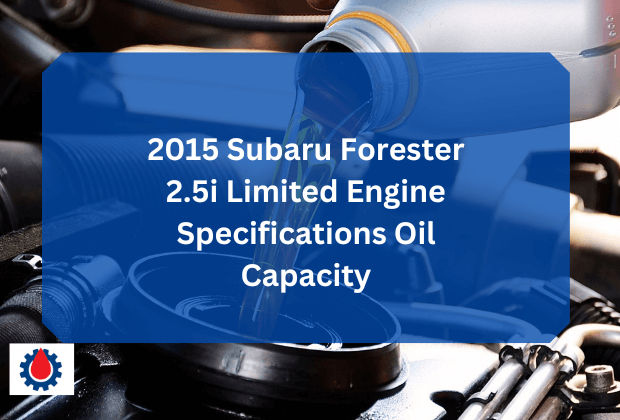When it comes to compact SUVs, the 2015 Subaru Forester 2.5i Limited stands out for its reliable performance, all-wheel-drive capability, and well-rounded engineering. One of the most vital aspects of this vehicle’s appeal lies beneath the hood: its engine.
If you’re a Forester owner or potential buyer, understanding the detailed engine specifications and oil capacity is essential for proper maintenance and longevity.
In this post, we’ll dive deep into the powertrain features and service requirements of this capable machine.
2015 Subaru Forester 2.5i Limited Engine Specifications Oil Capacity
| Parameter | Specification |
|---|---|
| Oil Capacity (with filter) | 5.1 quarts (4.8 liters) |
| Recommended Oil Type | SAE 0W-20 synthetic |
| Oil Change Interval | Every 6,000 miles or 6 months (whichever comes first) |
| Oil Filter Type | Subaru OEM 15208AA15A or equivalent |
Related Car Engine Oil Capacity Chart(Car Model A to Z)
Engine Specifications of the 2015 Subaru Forester 2.5i Limited
| Specification | Details |
|---|---|
| Engine Type | 2.5L DOHC 16-Valve Flat-4 Boxer |
| Displacement | 2,498 cc (2.5 liters) |
| Bore x Stroke | 94.0 mm x 90.0 mm |
| Compression Ratio | 10.0:1 |
| Valvetrain | DOHC with Dual Active Valve Control |
| Horsepower | 170 hp @ 5,800 rpm |
| Torque | 174 lb-ft @ 4,100 rpm |
| Fuel System | Sequential multi-port fuel injection |
| Engine Block Material | Aluminum alloy |
| Cylinder Head Material | Aluminum alloy |
| Engine Configuration | Horizontally opposed (flat) 4-cylinder |
| Fuel Type | Regular unleaded |
| Transmission | Lineartronic® CVT |
| Drive Type | Symmetrical All-Wheel Drive |
Related Engine Oil Consumption Chart(For All Engine Types)
Boxer Engine Design
What sets the Subaru Forester apart from the competition is its Boxer engine design. Unlike inline or V-type engines, the Boxer engine features pistons that move in a horizontal, opposing direction.
This design creates a more compact engine profile, reduces vibrations due to balanced firing, and lowers the vehicle’s center of gravity.
Benefits of this design include:
- Improved handling due to balanced weight distribution
- Enhanced safety in the event of a frontal collision
- Durability and longevity from balanced internal engine forces
This design philosophy is core to Subaru’s engineering identity and is a major reason why Foresters are known for long-term reliability.
Related Chevrolet Engine Oil Capacity Chart(Model A to Z)
Performance Highlights and Real-World Driving Experience
The 2.5i Limited delivers respectable performance for a compact SUV. The 170 horsepower output may not thrill sports enthusiasts, but it is perfectly tuned for everyday driving. The low-end torque, courtesy of the flat-four engine, provides decent acceleration and smooth highway cruising.
The Lineartronic CVT (Continuously Variable Transmission) complements the engine well, offering seamless gear transitions and better fuel efficiency than traditional automatics.
Though not sporty, the drivetrain provides confident performance, especially in snowy or wet conditions, thanks to Subaru’s legendary Symmetrical All-Wheel Drive.
Maintenance Tips for Optimal Engine Health
Keeping the engine in top shape requires more than just oil changes. Here are a few key maintenance tips specific to the 2.5i Limited’s engine:
- Use the right oil type: Always stick to 0W-20 synthetic oil as recommended in the owner’s manual.
- Change oil regularly: Stick to a 6,000-mile interval, but consider shorter intervals for frequent stop-and-go driving or extreme climates.
- Check oil levels often: Foresters are known to consume oil slightly faster than other vehicles; routine checks prevent issues.
- Inspect the timing chain system: This engine uses a timing chain instead of a belt, which generally lasts longer but should still be inspected at high mileage.
- Clean or replace the air filter: A clean air filter ensures optimal combustion and engine performance.
Related Deutz 4 Cylinder Diesel Engine Oil Capacity Chart
Real-World Reliability and Engine Longevity
The 2015 Subaru Forester 2.5i Limited has a strong track record for reliability, particularly with regular maintenance. The engine is designed to run for over 200,000 miles when properly cared for.
While the 2.5-liter engine has seen minor issues in past generations (notably head gasket leaks in the early 2000s), the 2015 model has largely resolved those concerns with updated designs and better materials.
Common longevity tips include:
- Regular oil and filter changes
- Coolant flushes every 60,000 miles
- Valve adjustment inspections at higher mileage
- Monitoring for oil consumption after 100,000 miles
Related Bobcat Engine Oil Capacity Chart(Model A to Z)
FAQ
How much oil does a 2015 Subaru Forester 2.5i take?
The 2015 Subaru Forester 2.5i, when equipped with the 2.5-liter non-turbo engine, takes 5.1 quarts (4.8 liters) of oil with a new oil filter installed.
How much oil does a 2015 Subaru 2.5 take?
If you’re referring to any 2015 Subaru vehicle with a 2.5-liter non-turbo engine (like the Forester 2.5i or Outback 2.5i), it typically takes around 5.1 quarts (4.8 liters) of SAE 0W-20 full synthetic oil with the filter.
Can I use 5W-30 instead of 0W-20 in Subaru Forester?
While SAE 0W-20 is the manufacturer-recommended oil for the 2015 Subaru Forester 2.5i due to its fuel efficiency and cold-start performance, 5W-30 can be used temporarily if 0W-20 is unavailable.
However, it’s best to return to 0W-20 at your next oil change. Long-term use of 5W-30 may affect fuel economy and isn’t recommended unless specified under certain operating conditions in your owner’s manual.
What is the engine capacity of the 2015 Subaru Forester?
The engine capacity of the 2015 Subaru Forester 2.5i is 2.5 liters, which equals 2,498 cc (cubic centimeters). It’s a 2.5L DOHC 16-valve flat-four Boxer engine, producing 170 horsepower and 174 lb-ft of torque.
Final word
The 2015 Subaru Forester 2.5i Limited’s engine strikes a balance between practical performance, durability, and fuel efficiency. While it may not pack turbocharged thrills, its Boxer engine, coupled with a thoughtful drivetrain, offers long-term value and confidence in various driving conditions.




